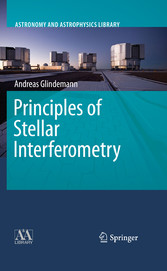Search and Find
Service
Principles of Stellar Interferometry
3
Preface
Preface
Contents
Contents
List of Symbols, Notations and Abbreviations
List of Symbols, Notations and Abbreviations
1 Introduction
18
Chapter 2 Propagation of Light
22
2.1 Preliminaries
23
2.1.1 Basic Properties of the Electromagnetic Wave
23
2.1.2 Young's Experiment
26
2.2 Scalar Diffraction Theory
30
2.2.1 The Rayleigh–Sommerfeld Diffraction Formula
30
2.2.2 Fresnel Approximation
33
2.2.3 The Airy Disk
36
2.3 The Coherence Function
42
2.3.1 Varieties of the Coherence Function
43
2.3.2 Generalised van Cittert–Zernike Theorem
49
2.3.3 Incoherent Sources of Light: Stars
51
2.3.4 Quasi-Monochromatic Approximation
54
2.4 Young's Experiment Revisited
61
2.4.1 The Coherence Function in Young's Experiment
62
2.4.2 ABCD Method
67
2.4.3 Power Spectrum of the Fringe Pattern
68
2.4.4 Heuristic Approach
73
2.5 Higher Order Correlation Functions: Intensity Interferometry
79
Chapter 3 Imaging Process: Propagation Through Optical Systems
90
3.1 Fourier Optics
91
3.1.1 The Optical Transfer Function
93
3.1.2 Optical Aberrations: The Zernike Polynomials
99
3.2 The Coherence Function
105
3.2.1 Image Intensity Distribution
105
3.2.2 Coherent Imaging
109
3.2.3 Coherence Properties in the Image Plane
116
3.3 Propagation Through Interferometers
120
3.3.1 Young's Experiment with a Lens
121
3.3.2 Apertures of Finite Size
127
3.3.3 Spectra of Finite Width
133
3.3.4 Objects of Finite Size
139
3.3.5 Considerations on the Interferometric Field of View
145
3.3.6 Masked Field of View
149
3.4 The uv-Plane
156
3.4.1 Large Apertures, Short Baseline: The LBT
158
3.4.2 Large Apertures, Long Baselines: The VLTI
161
3.4.3 Image Reconstruction: General Principles
166
Chapter 4 Atmospheric Turbulence
173
4.1 Kolmogorov Turbulence
174
4.1.1 First Principles
174
4.1.2 Index of Refraction Fluctuations
175
4.2 Statistical Properties of the Perturbed Complex Wave
180
4.2.1 Thin Layer Turbulence Model
180
4.2.2 Multiple Layers, the Fried Parameter
182
4.2.3 Anisoplanatic and Temporal Effects
188
4.3 Propagation Through Optical Systems
194
4.3.1 Fringe Motion
194
4.3.2 Image Motion
206
4.3.3 Zernike Representation of Atmospheric Turbulence
210
4.3.4 Scintillation
214
4.3.5 Speckle Pattern and Seeing Disk
216
4.4 Speckle Interferometry
224
Chapter 5 Instrumental Techniques
232
5.1 Combination of Two Telescopes
233
5.1.1 Fizeau Configuration
233
5.1.2 Michelson Configuration
237
5.1.3 Co-Axial Combination
241
5.2 Multi-Aperture Combination: Michelson Configuration
249
5.2.1 Multi-Axial and Co-Axial Combination
249
5.2.2 Aspects of Beam Combination
254
5.3 Multi-Aperture Combination: Direct Imaging
258
5.3.1 Fizeau Configuration
259
5.3.2 Hypertelescope
261
5.3.3 Interferometric Remapped Array Nulling: IRAN
264
5.3.4 Nulling Interferometer
272
5.4 Layout of Interferometer Arrays
278
5.4.1 Many Apertures
278
5.4.2 Few Apertures
283
5.4.3 Delay Lines
286
Chapter 6 Observing Through Atmospheric Turbulence
290
6.1 Visibility Measurement Through Atmospheric Turbulence
291
6.1.1 Power Spectrum of the Fringe Pattern
298
6.1.2 ABCD Method
302
6.2 Beating Atmospheric Turbulence
308
6.2.1 Fringe Tracking
308
6.2.2 Dual-Feed System
316
6.2.3 Closure Phase
321
6.3 Adaptive Optics
325
6.3.1 Wave Front Sensing
326
6.3.2 Closed Loop Operation
328
Chapter 7 Modern Interferometers
331
A Appendix
333
A.1 The Fourier Transform
333
A.2 Atmospheric Transmission Bands
336
References
338
Index
349
All prices incl. VAT












